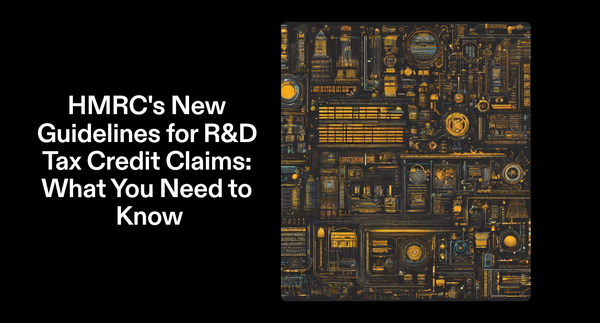RDEC: Guide to the UK Research and Development Expenditure Credit
In this article, we provide a detailed guide to everything you need to know about the UK Research and Development Expenditure Credit – more commonly known as the “RDEC” for short.

Here we provide a detailed guide to the Research and Development Expenditure Credit Scheme (RDEC) for large companies or SMEs in receipt of grants
What is the RDEC tax incentive and who can benefit?
The RDEC (which stands for 'Research and Development Expenditure Credit') is a UK Government tax incentive aimed at rewarding innovative companies for seeking to push the boundaries in their field through investment in R&D activities. For example, investment in new or improved products, services, software or processes.
The RDEC relief is aimed at ‘Large companies’ (see definition below) or it can also be claimed by SMEs (typically those SMEs in receipt of grants).
It replaces the legacy 'Large Company R&D Tax Relief Scheme' which was less attractive in terms of the benefits that the RDEC now offers.
In summary, this tax incentive caters for larger companies that are unable to qualify for the more generous SME R&D Tax Credit Relief.
Overview: What are the key benefits of the RDEC tax relief?
The RDEC provides a reduction in corporation tax payable for profitable companies or a repayable tax credit for loss-making companies.
The RDEC benefit equates to a rate of 11% of the total qualifying R&D expenditure in the period i.e. 11p for every £1 invested into qualifying research and development.
The RDEC allows for greater flexibility for Large Companies as they were previously ineligible for tax credit payments in loss situations up until 1 April 2013.
Although, it is less generous than the SME R&D tax credit relief.
RDEC: What costs are eligible?
The following costs are eligible under the RDEC scheme:
- staffing costs paid to directors/employees
- expenditure on externally provided workers
- software and materials
- contributions to independent research
- subcontracted – limited to qualifying bodies and individuals/partnerships
This is broadly similar to the definitions for SME R&D tax credits, although particular note should be taken of the more restrictive interpretation of qualifying subcontracted costs.
What is the RDEC rate?
The current RDEC rate is 13% (this represents a 1% rate increase from 12% up to 1 April 2020).
However, the effective rate is actually 11% as the R&D credit uplift is taxable under the RDEC. Specifically, the effective cash tax saving is £10.53 on every £100 spent (at a 19% corporation tax rate).
RDEC Example Calculation
As an example, £100,000 of qualifying expenditure is uplifted by the 13% taxable credit generating a credit of £13,000. After applying this enhanced expenditure to the 19% current corporation tax rate, the remaining cash benefit claimable under the RDEC is £10,530 i.e. 10.53% (rounded up to 11%), this is the effective percentage return on qualifying expenditure.
Note that there are other conditions that must be satisfied before a cash tax credit is payable to the company under the RDEC scheme (see further below).
Why is the RDEC referred to as an ‘above the line’ (ATL) credit?
The credit claimed under the RDEC is recognised as income within pre-tax profits in your income statement (and not within the tax line, unlike the SME R&D tax relief).
This gives it increased visibility as it is disclosed above the tax line. This has been a historical criticism of the SME R&D tax relief in that the benefit is not visible to most readers of accounts as it is recognised in the 'tax line' only. The RDEC seeks to remedy this limitation.
This is why it is often referred to as an ‘above the line‘ credit.
Can large companies claim R&D tax credit rebates if loss-making?
Large companies that are ineligible for the SME R&D tax credit relief can claim payable R&D tax credit rebates from HMRC under the RDEC relief if they are loss-making.
This was not previously possible under the old legacy 'Large Company' relief which ended from 1 April 2016.
RDEC: 7 steps to receiving your cash tax credit rebate
The 7 stage process is designed to ensure that only those companies that are up-to-date with their tax affairs and payments can benefit from the cash tax rebate option.
Note that with effect from 1 April 2019, any amendments made to include claims for RDEC relief must be filed in a revised and complete CT600 return.
We are going to simplify the 7 step test to ‘just’ 5 for our purposes. These five stages may be summarised as follows:
- Deduction of corporation tax at the main rate
The repayable tax credit is payable only after first deducting the corporation tax due (including on the tax credit) in the period - PAYE / NIC cap
The repayable tax credit is capped by the PAYE/NIC amount paid by the company in the period in relation to the staff engaged in the R&D – note that this cap does not take into account the % apportionment applied to the employee staff costs as part of the claim calculation - PAYE / NIC / VAT arrears payable first
The repayable tax credit is payable to the company only after HMRC has checked for any outstanding corporation tax, PAYE / NIC or VAT arrears that will be deductible against the credit in advance - Optional set off against group company CT liabilities
The repayable tax credit can be offset against corporation tax liabilities of group companies in the period - Going concern requirement
The company must be a going concern to be entitled to the cash tax credit
Yes– we’ve simplified the 7 stage test into 5 to capture the key points within HMRC’s requirements.
RDEC v SME R&D Tax Credit Scheme: What are the differences?
The key differences are the rates of relief and the way in which the relief is calculated and applied (as set out above).
You can see the different approach to the calculation of the SME relief here.
There are also some other subtle differences as follows:
RDEC: No eligible subcontractor costs
In terms of the qualifying R&D expenditure, there is one key difference and this is in relation to subcontracted costs.
Unlike under the SME scheme, subcontracted costs to third-parties are not eligible under the RDEC relief. However, it should be noted that ‘externally provided workers’ (EPWs) are an eligible cost and, therefore, it is more important than ever to get the distinction right between EPWs and subcontractor relationships when dealing with RDEC claims.
Finally, it should be noted that in the specific exception where the subcontracted costs relate to work subcontracted to qualifying bodies such as Unis or to individuals, the 65% cap that applies under the SME relief does not apply for RDEC purposes.
Aside from the fundamental difference in application and approach to give effect to the tax relief within the financial statements of a company, the underlying R&D definitions that underpin the applicability of the SME R&D tax relief remain the same.
'Above the Line' Methodology
The SME relief is recognised solely within the corporation tax line within the company accounts ('below the line' i.e. below the profit or loss total). This means that the relief often goes unnoticed by the casual reader of the accounts as it is not featured within the operating income and expenditure i.e. 'above the line': within in the main part of the financial accounts above the profit or loss figure.
The RDEC aimed to change this methodology and approach by recognising the tax credit as a taxable (above the line) credit. This was intended to give more prominence to the eligible expenditure on research and development and the resulting tax credit that it has generated for the company.
How do you file an RDEC claim with HMRC?
With respect to the process for filing a claim, a company is required to prepare and file a technical justification report that supports the underlying nature of the qualifying project work along with supporting claim calculations in the same way as under the SME R&D scheme.
This R&D report accompanies the CT600 company tax return and supporting computation that includes the R&D Expenditure Credit claim figures.
RDEC tax credit incentive: Some practical issues to consider
The RDEC is applied in a fundamentally different way to the SME R&D tax credit scheme and therefore there are a number of issues to consider:
- How the tax credit is treated in the profit and loss account under accounting standards – sometimes it is classified as a grant; however, this is for discussion with your accountants or auditors
- Impact on the financial accounts going forward if an estimate is of the tax credit is included or the claim is later challenged by HMRC and subsequently reduced. It is important to track the credit subject to tax in the accounts and to make any adjustments in the tax computation for under or overcharges to taxation
- Impact on quarterly instalment corporation tax payments should be considered for cash flow planning purposes given that the tax credit calculation has the effect of increasing taxable profits
- Impact on the effective tax rate for group tax planning given the higher profits subject to tax after taking into account the above the line tax credit.
Don’t forget about the Patent Box...
The RDEC has been designed to work alongside the Patent Box and therefore companies with qualifying patents should ensure that they have considered how to optimise the Patent Box tax relief in addition to the RDEC.
How we can help you with your RDEC claim
We are specialists in the analysis and preparation of R&D tax credit claims and can offer an end-to-end solution in preparing and filing your RDEC claim with HMRC.
We are also accountants so this means that we can also advise on how your claim fits into the ‘bigger picture’ of your overall company tax profile.





